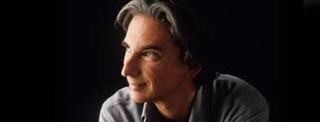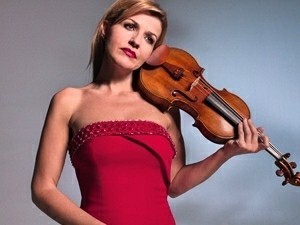|
Back
The Breath of the Mediterranean New York
Isaac Stern Auditorium, Carnegie Hall
04/28/2015 -
Franz Schubert: Incidental Music from Rosamunde, D. 797
Alban Berg: Violin Concerto
Norbert Moret: En rêve (NY Premiere)
Claude-Achille Debussy: La Mer
Anne-Sophie Mutter (Violin)
New World Symphony, Michael Tilson Thomas (Artistic Director and Conductor)

M. Tilson Thomas (© michaeltilsonthomas.com)
Michael Tilson Thomas, the founder and Artistic Director of the New World Symphony, calls this (officially) “America’s Orchestral Academy”. But, unlike his precise movements as a conductor, this is, to say the least, a nebulous description.
As described earlier on ConcertoNet, the Miami-based international ensemble, which basically changes each four years, is comprised of young professional musicians all on a Fellowship, who become accustomed to the full repertoire of music, with leading soloists, teachers and conductors.
Last night, their Carnegie Hall performance certainly provided a diverse repertoire from four countries for the international group, Mr. Thomas himself on the podium, and one of the world’s greatest violinists playing two works with the company.
Truth be told, the New World Symphony is not the New York Philharmonic by a long shot. At times, in the opening Schubert, their winds were fuzzy, at times in the Debussy, their shape disappeared under the waves of music. And they didn’t have that distinguishing color which only the most distinguished ensembles can achieve.
But this was a most challenging program, and they still had an effect on an audience which was decidedly on their side, enthusiastically applauding them on in between every movement. (Usually these interruptions can be tolerated. But when Anne-Sophie Mutter played the Berg Violin Conceto, a work so unified–not only by the tone-row but by the picture of a young girl–such enthusiasm was, literally, disconcerting.)
Ms. Mutter has always played this with the utmost sensitivity and feeling, and here, Mr. Tilson Thomas provided excellent accompaniment. From the first harp and violin introduction to the fadeout at the end, this is a concerto which cannot help but move even the most conservative listener.
One expected Ms. Mutter do underplay her role. Such solo lines, even the most virtuosic sections, speak for themselves. And the New World Symphony itself responded to the great outbursts. As to the part we always wait for, the Bach chorale to Es ist genug, one can see true compositional genius. Shostakovich, played here so frequently, blatantly offers his quotes from other composers. Berg works in his Bach as though it had been written in 1935, not two-and-a-half centuries earlier.

A.-S. Mutter (© Courtesy of the Artist)
By far the most unusual work was the New York premiere of En rêve (“In a dream”) by the hermetic Swiss composer Norbert Moret, a man who shunned the public spotlight, except at a conductor. M. Moret studied with the finest composers of the 20th Century. In Paris, he worked with fellow Swiss Arthur Honegger, as well as Olivier Messiaen and René Leibowitz. In Vienna, he worked with Wilhelm Furtwängler, who, though best known as a conductor, was a severe Late Romantic composer of the Pfitzner School.
Nothing of Furtwängler was found in his work here, a composition he wrote ten years before his death, in 1988 for a very young Anne-Sophie Mutter. (His only other celebrated piece was a cello concert for Mstislav Rostropovich. He obviously had to work with the best.) M. Moret must have been entranced with the 25-year-old artist, for this de facto concerto is absolutely luminous. Why it was never played in New York before, especially by the increasingly adventurous Ms. Mutter, is a mystery.
The orchestration here is peculiar. Outside of two horns, strings, and soloist, the music is purely percussive: vibraphone, tam-tam, celesta etc. And yes, at times, Ms. Mutter played duets with the timpani, her high notes were in harmony with the vibraphone and celesta. At other times, the string orchestra and horns made a mysterious, whispery pattern with the soloist.
But this description detracts from the sheer beauty of the music itself, an impressionistic picture of three “dreams” from the composer. “Hazy Light” sounded much like the preceding Berg Concerto, with elusive tone-rows, whispers of melodies, the violin darting around the orchestra like a will-o’-the wisp. Yet this fit in directly with the composer’s so-poetic description, of a forest, “the darkness penetrated by rays of light...a swarm of gnats forming an apparent figure-eight...not solid at all…the center teeming with life...”
Etc. etc. Evocative descriptions worthy of a Baudelaire.
The second movement, “Dialogue with the Star”, needed no words (though M. Moret did offer more poetry). This was a semi-cadenza, extraordinarily difficult, yet yielding far more than pyrotechnics. Whether working with the kettledrums or the celesta, Ms. Mutter took these singular angular lines and produced, as with the Berg, a memory, a picture.
M. Moret ended with, what he called “a song.” Titled “Fascinating Blue: A Ticinese Serenade”, it was fun, a romp, its 20th Century dissonances and rural fire, a joy to this most adventurous soloist, and what seemed to be success for the orchestra.
Ms. Mutter was bookended with two relatively mainstream works. Yet I had never heard the opening of Schubert’s Rosamunde played with such Italianate color. Well, Italian the way Mozart was Italian. But Mr. Tilson Thomas produced a lyrical set of arias for this overture, something pre-Weberian, and quite the light beginning.
While Debussy was the only French composer, the entire evening breathed the Mediterranean air. Though ironically not so much in La Mer. Perhaps I am simply accustomed to the most precise orchestras bringing out these colors, and New World didn’t quite have it. Mr. Tilson Thomas conducted them with great volume (even too much at times), the final horn chorale was not quite architecturally etched out for effect, but it is still a magnificent work.
No problems whatsoever for the encore. Those who stayed heard the Bizet Farandole from L’Arlésienne played with fervor, fun, dancing, and the kind of uninhibited (yet accurate) music making which made Carnegie Hall resonate with joy.
Like Schubert and Berg, one must ask what Bizet’s music would have been like had he (and they) lived to a decent old age. But how thankful we are that their products show no age whatsoever.
Harry Rolnick
|